Gallo Pinto Recipe (Costa Rican Rice and Beans)
~ This Gallo Pinto recipe was taught to us by a Costa Rican exchange student who craved it while visiting the U.S., far from the comforts of her home. It’s so much more flavorful than “plain beans and rice” yet it’s super quick and easy to make (in less than 10 minutes). And although Costa Rican rice and beans are most often served as a breakfast dish, our friend ate it all day long, and now we do, too. It’s fantastic for brunch, a side dish, even a meatless main course at dinner! ~
This Recipe Is: • Ready in 30 Minutes or Less • Make Ahead • Vegetarian • Gluten Free •
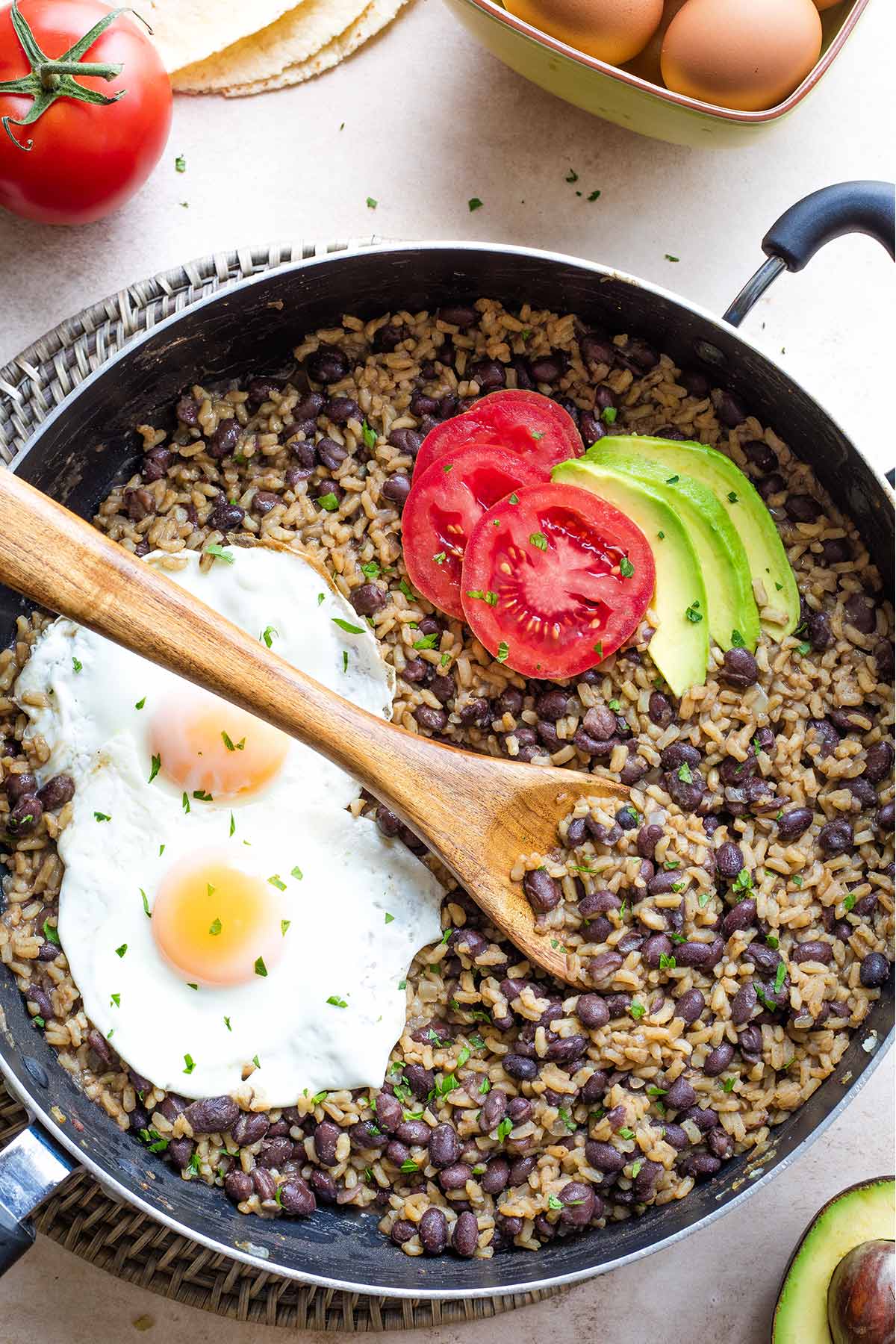
Thanks to a very special exchange student, this Costa Rican national treasure has become our family’s beloved treasure – and now it can be yours, too!
How We Came to Love Gallo Pinto
When my daughter was in high school, we hosted a wonderful young Costa Rican student on an exchange trip. Of all the many memories we all have of Nana (pronounced NAH-Nah), the #1 thing that immediately wove itself into the fabric of our family was her recipe for Gallo Pinto.
She’d brought a bottle of the all-important Lizano sauce in her luggage, so she could share her culture with us in one of the ways that meant the most to her. (Lizano is the key ingredient that makes Gallo Pinto so delicious and sets it apart from other rice and beans recipes like our 5-Minute Easy Rice and Beans … more on that in a bit.)
Even as Nana happily tried all the “classic” American foods we introduced her to, she admitted that she still really, really missed the flavors of home. Specifically Gallo Pinto, which she said she ate every single morning for breakfast, and actually all throughout the day for other meals, too.
Well, ok!
We wanted Nana to feel at home, eating foods that gave her a bit of comfort.
And – heck yeah! – we wanted to try this piece of her culture that she promised us was crazy-good enough to eat for every meal of the day, every day of the week!
So we gathered ’round the stove as Nana started her cooking lesson, took notes and pictures (because … you know … we’re food bloggers!), and then triumphantly brought Nana’s creation to the table (with more notes and pictures, for sure).
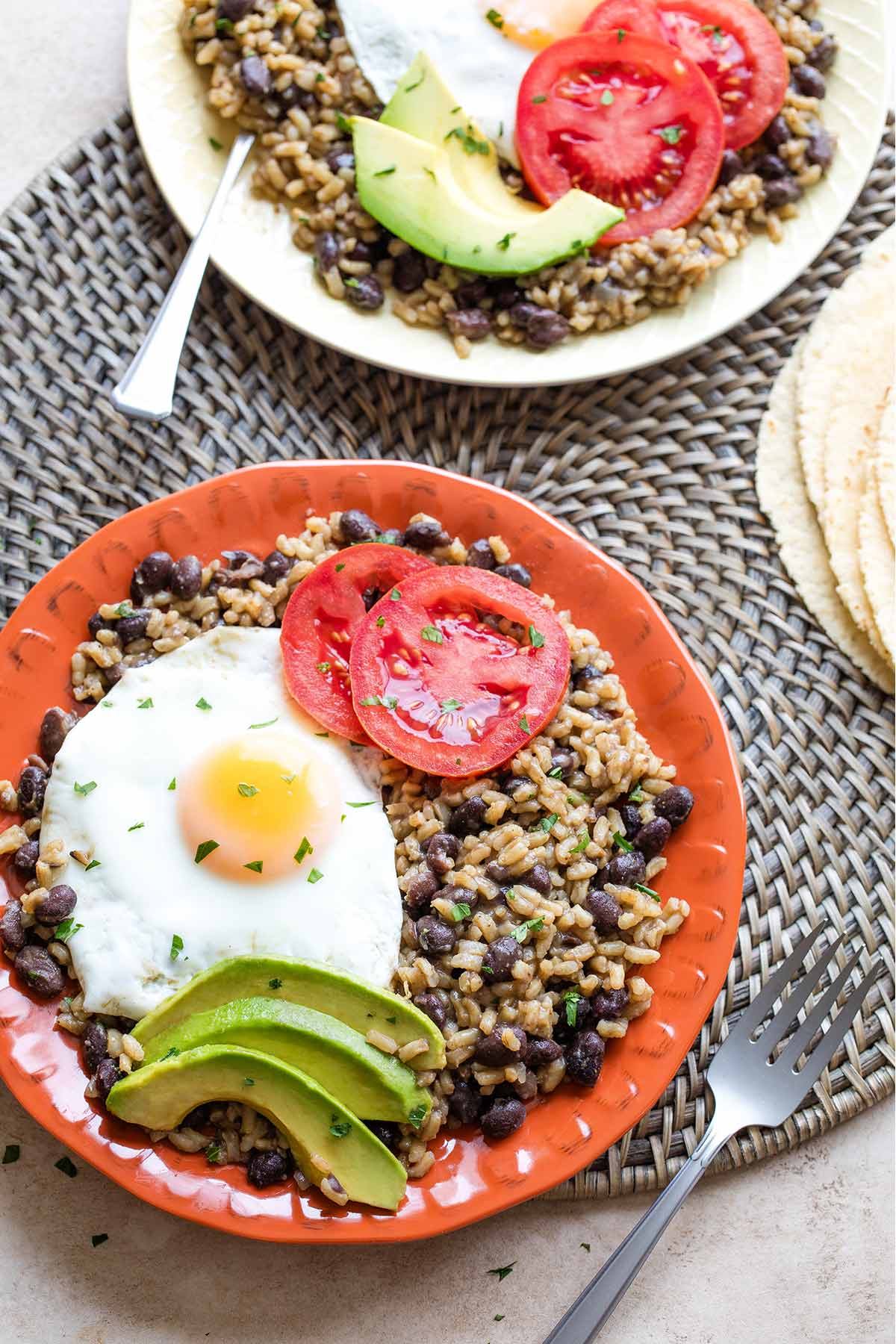
And we were blown away. This was definitely no ordinary plate of plain ol’ bland beans and rice.
No wonder Nana missed eating it every day!
And so, even long after we tearily hugged Nana goodbye at the airport, we still make her favorite dish all.the.time.
It’s super easy, super flexible, and keeps great in the fridge to reheat for days!
So What Is Authentic Costa Rican Gallo Pinto?
Nana was very clear that (just like so many other prized cultural recipes), every Costa Rican family has their own way of making this. Their own little tweaks that make it authentically theirs.
The name Gallo Pinto means “speckled rooster” in Spanish, supposedly a nod to the speckled appearance of the beans mixed throughout the rice.
And that’s really the core of this recipe … just a speckley mix of beans and rice (usually black beans).
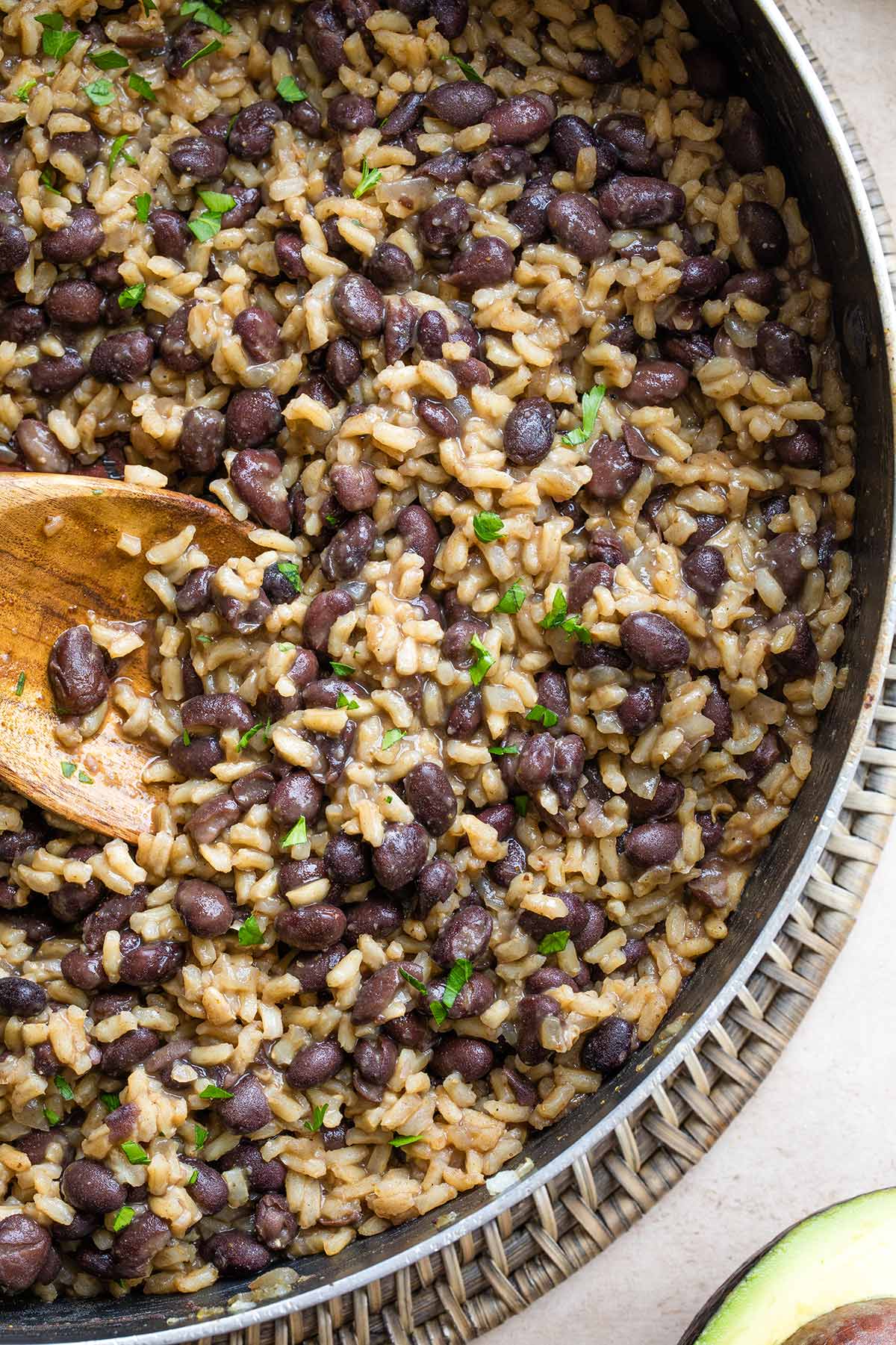
But it’s so very much more than that.
Different variations include vegetables such as onions and bell peppers, as well as garlic and cilantro. Again … every family has their own, favorite mixture.
Nana was adamant (and I mean 100% absolutely adamant) that “simple is better” and she never, ever wanted us to add any vegetables to ours.
I know she’d be horrified that we’ve stretched her authentic, family version to include some chopped onions. But, I guess that just means that our family has evolved our own, special version (that mostly sticks very very closely to just the way Nana taught us)!
Now, where this dish really grabs unique, memorable flavor and becomes so very much more than “just rice and beans” is in the flavorful seasoning offered by Lizano sauce.
What Is Lizano Sauce?
Lizano sauce (Salsa Lizano) is a rich, savory blend of vegetables and spices.
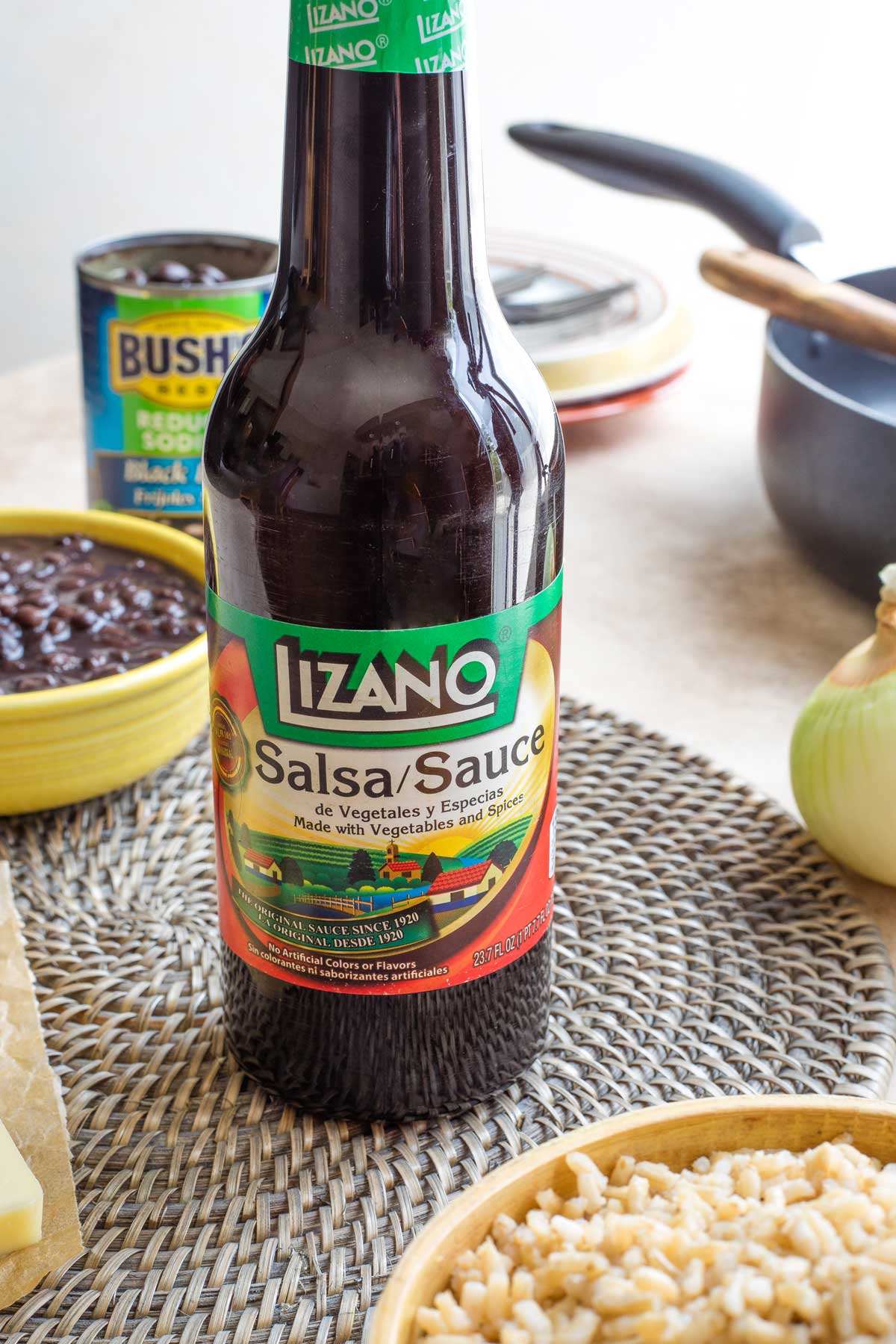
And it’s absolutely worth tracking down (especially since Amazon is happy to send it right to your door if your local supermarket doesn’t have it).
I do usually grab mine on Amazon, although it’s often available in Latin groceries or in the international aisle of big supermarkets, too.
Luckily, Lizano keeps well in the fridge for a long time, so it’s worth having on hand for all the “I-Neeeed-Gallo-Pinto” moments that are definitely in your future!
As with everything else that can vary in this recipe, there’s wide variation in how much of the Lizano seasoning sauce different people use.
Nana was clear with us about how much she and her family use, although I’ve seen recipes that use only a couple of tablespoons, which hardly seems enough to even taste. But as you get into the habit of making this recipe (because you’ll want to enjoy it often!), you can use whatever amount tastes good to you.
NOTE: You’ll sometimes see Lizano likened to Worcestershire sauce, but I promise you that Worcestershire isn’t a good substitute. It’s only worth making this recipe if you’ve got Lizano, and I truly think you’ll be glad you waited for the “real thing”!
Is Gallo Pinto from Costa Rica?
I’m not going to get in the middle of any national arguments about exactly where Gallo Pinto originated. But yes – it’s generally considered to be closely tied to Costa Rica, as well as Nicaragua. Both countries specifically claim it as their invention, and hail it as their national dish.
So let’s get you started on making this cultural food icon a reality in your own kitchen! It’s so super easy, I promise!
How to Make Costa Rican Rice and Beans
Ingredient Prep
One of the great things about this recipe is that there’s hardly any prep work to be done at all, besides opening a can of beans and maybe chopping some onions or cilantro (or other veggies if you want them).
You can have it on the table – start to finish – in under 10 minutes!
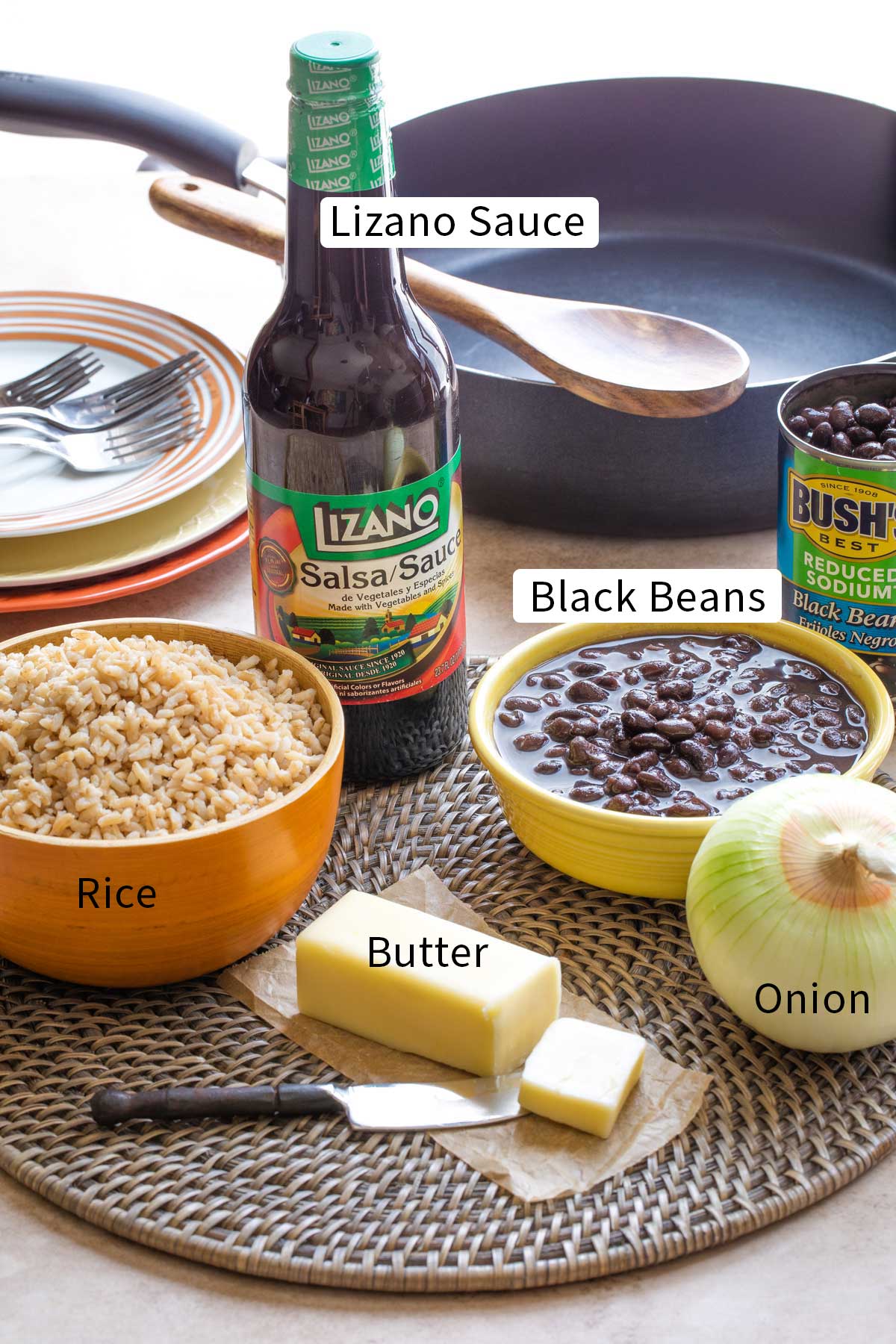
Remember: DON’T Drain Those Beans!
A hugely important note here is that you are NOT draining and rinsing your canned beans. You’re actually going to be including some of the bean liquid in the recipe, so DO NOT drain and rinse them!
Also, notice that you’re starting with already-cooked rice.
- This can be leftover rice you’ve got in the fridge.
- Or, you can cook some rice specifically for this recipe. (To make it quick and easy, I often grab microwavable packs of rice from the freezer section, or fast-cooking packets of “ready rice,” which you can snag in the grocery aisles and then microwave in 90 seconds. Whatever’s fastest and easiest for you.)
How Wet Is Your Rice? (It Affects Your Measurements!)
We prefer our rice to be a little bit wetter (if possible) and not overly dried out. That leads to a looser, saucier Gallo Pinto, which is like what Nana taught us to make, and also like what our daughter, Amy, experienced when she got to visit Nana in Costa Rica.
Depending on how your rice was prepared and how long ago it was pre-cooked (and how long it’s been hanging out in your fridge), it will probably vary a little in moisture content every time you make this.
Not a problem. (Remember, this recipe is very flexible and forgiving!)
But, how wet your rice is may affect how compacted it is when you measure it out (and therefore precisely how much rice will be in your 4-cup measurement), how much Lizano you’ll want to flavor that amount of rice, and also the final texture of the dish.
When you’re ready to cook, here’s all you do …
Step #1
Melt a little butter in a large, nonstick skillet over medium heat.
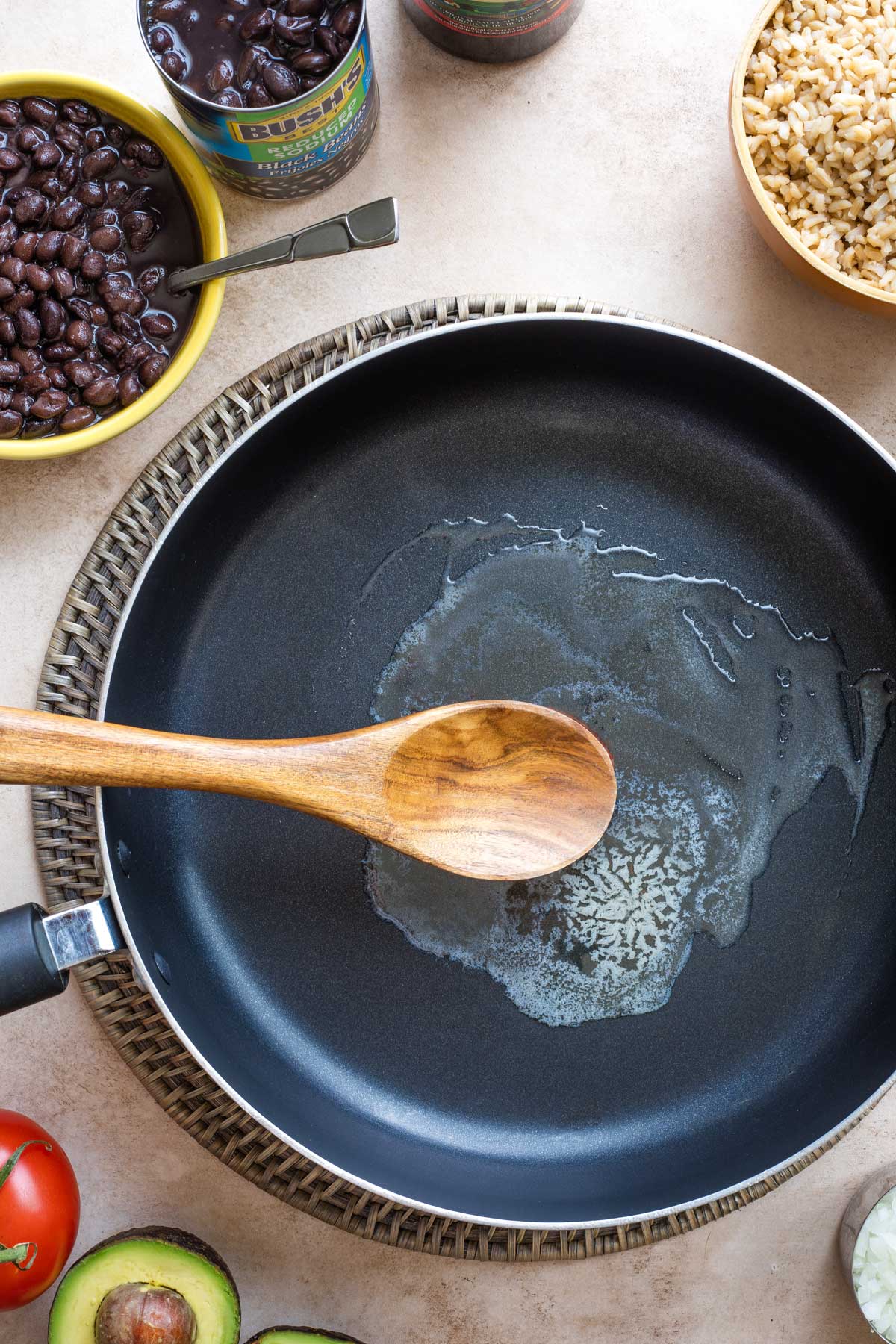
(Optional) Step #2
Again, you don’t have to use onion. Nana absolutely never did.
But my family likes it. And lots of other Costa Rican families add onion, and even bell pepper.
It’s up to you, but here’s the step where you’d add that if you want to.
Cook your onion (and also bell peppers if you’re using them), until it’s beginning to soften but isn’t yet getting browned – that’ll take about 2 minutes or so.
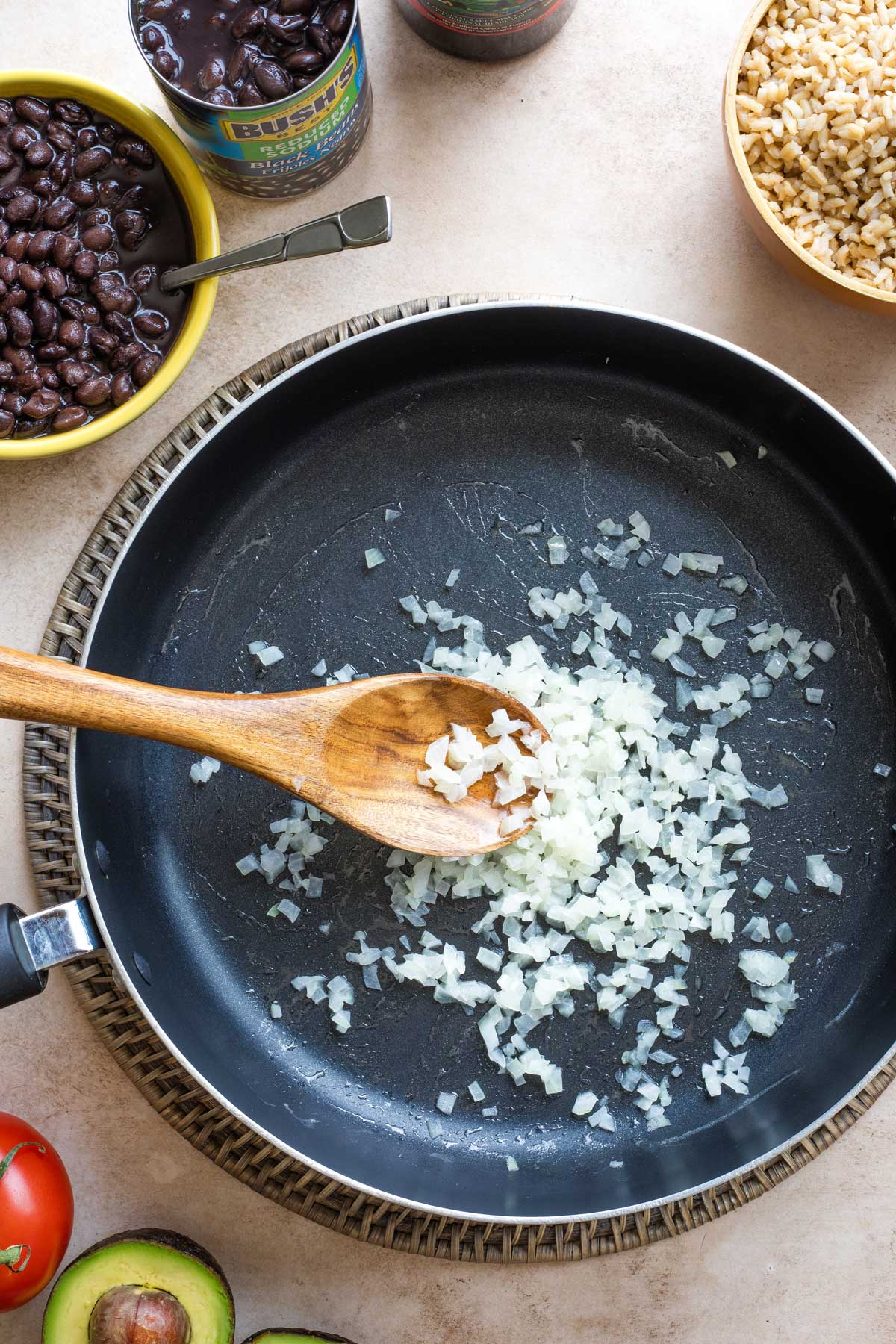
Step #3
Next, add the rice to your pan and cook it just long enough to warm it through.
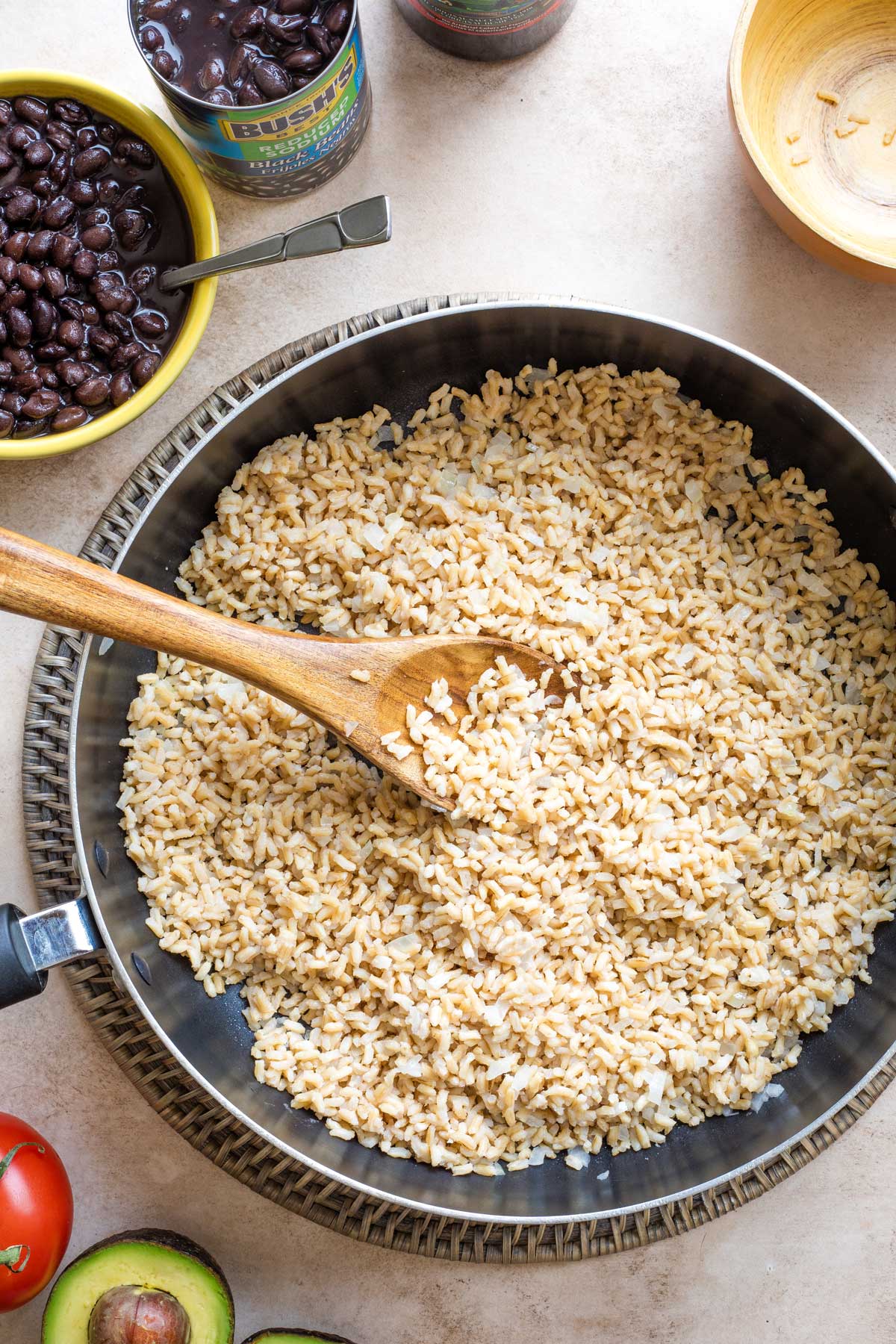
That should really only take a minute or two, depending on how cold your rice is to begin with (if you’re taking it stone-cold out of the fridge, it might need a little extra time).
Step #4
Next, add your Lizano sauce and stir it in thoroughly, so it’s completely distributed into the rice.
How Much Lizano Do You Want to Use?
This is a good time to give your Gallo Pinto a taste, and decide how much Lizano seasoning you’d like to use.
We recommend starting with ½ cup, but you may want to start with even less.
But, you may want to scale all the way up to ⅔ cup of Lizano, depending on factors like: (1) how wet (or dry) and compacted your rice is when you measure it, (2) how many toppings you’ll be adding (eggs, avocado, tomato, etc.), and (3) whether you used reduced-sodium (vs. regular, saltier) black beans.
I actually find that the “exactly right” amount of Lizano can vary a little from batch to batch, every time we make this (depending on factors like those I just mentioned).
Let your taste preferences be your guide.
Remember: you can always add more or pass it ’round the table for everyone to season their own.
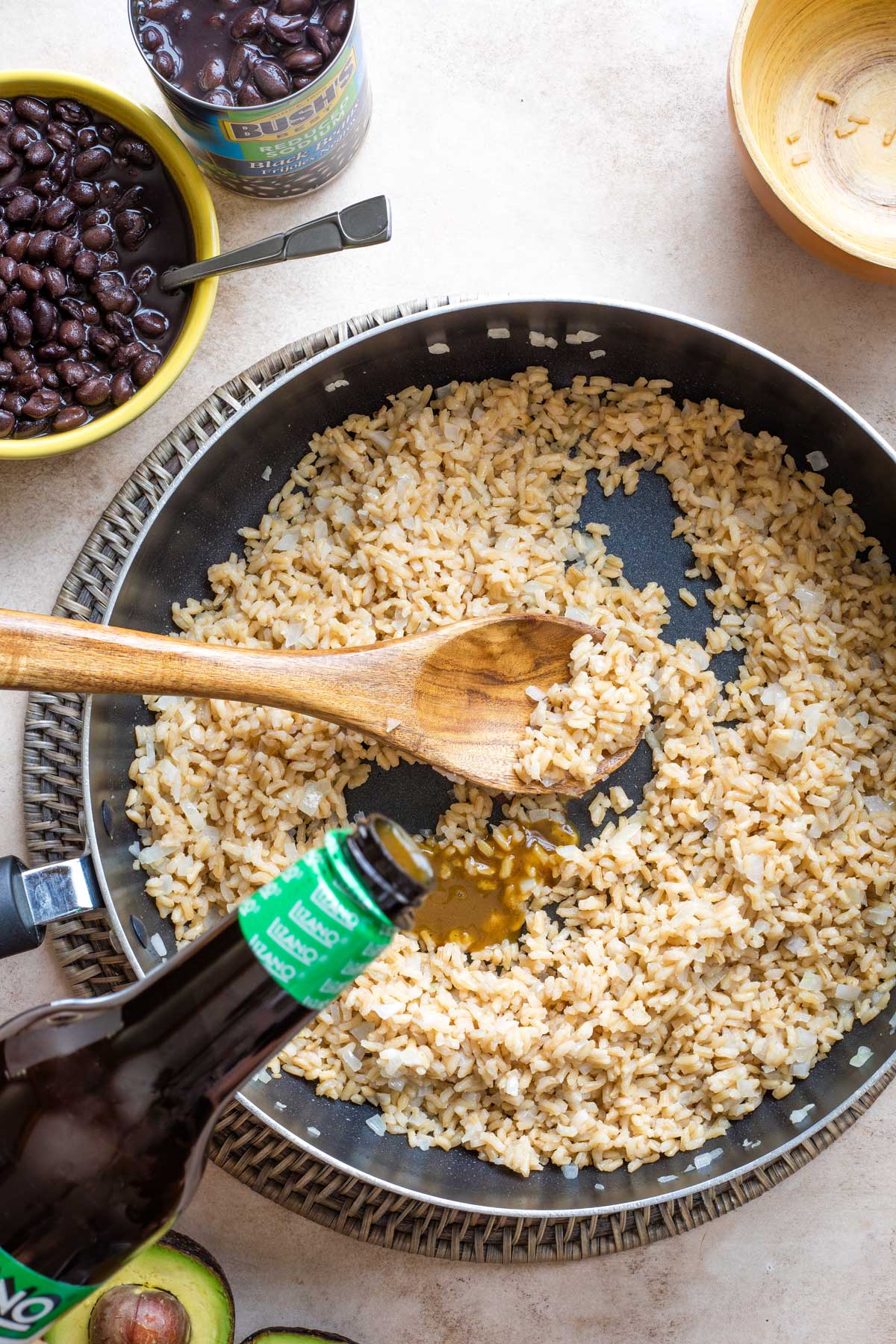
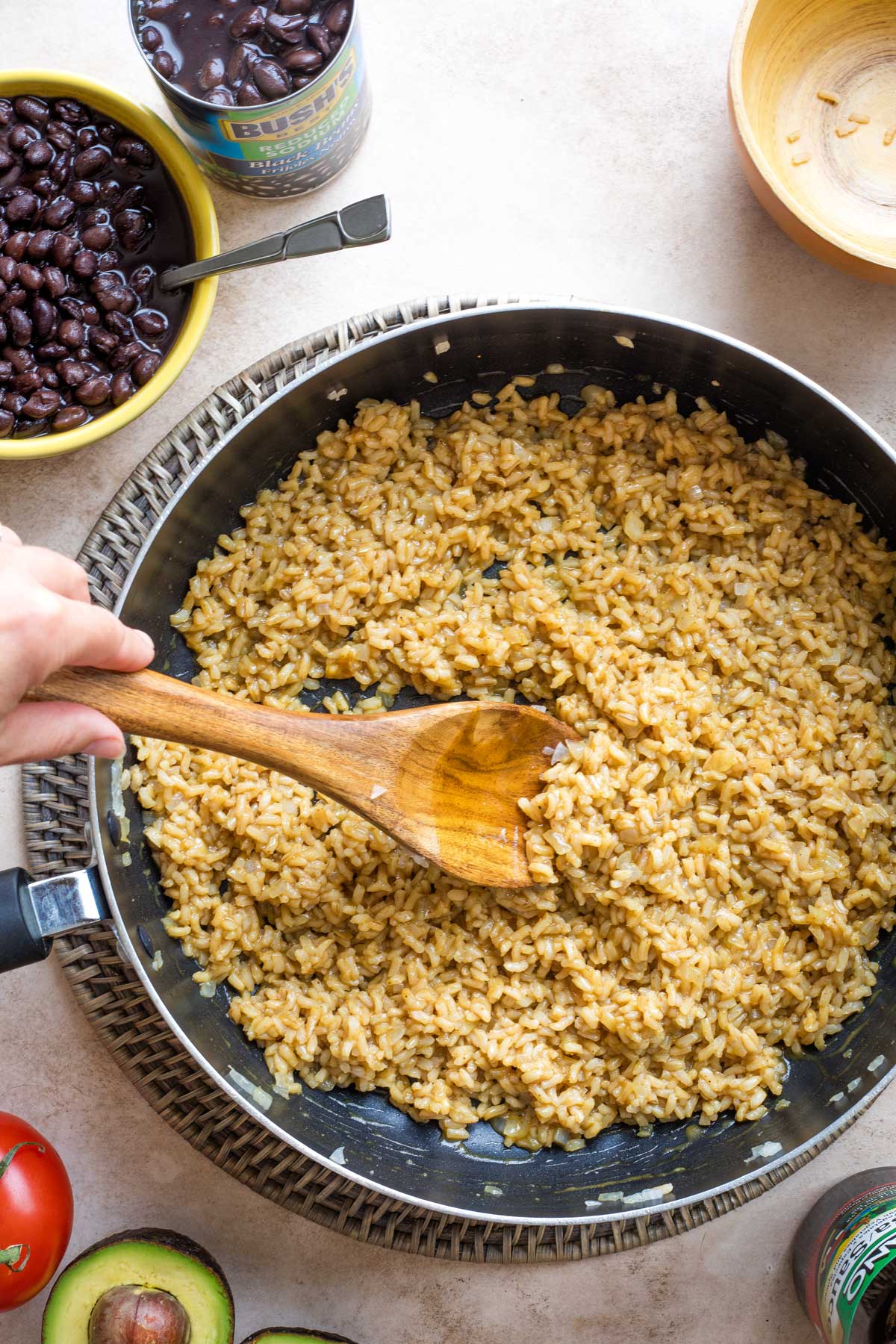
After you’ve added your Lizano, spoon your beans straight out of the can (without rinsing or draining them). They’ll have some bean liquid coating them, which is what you want.
Then, scoop about 2 tablespoons of the bean liquid from the bottom of the can, and add that in, too. You don’t have to be super-precise in measuring this – just ballpark it.
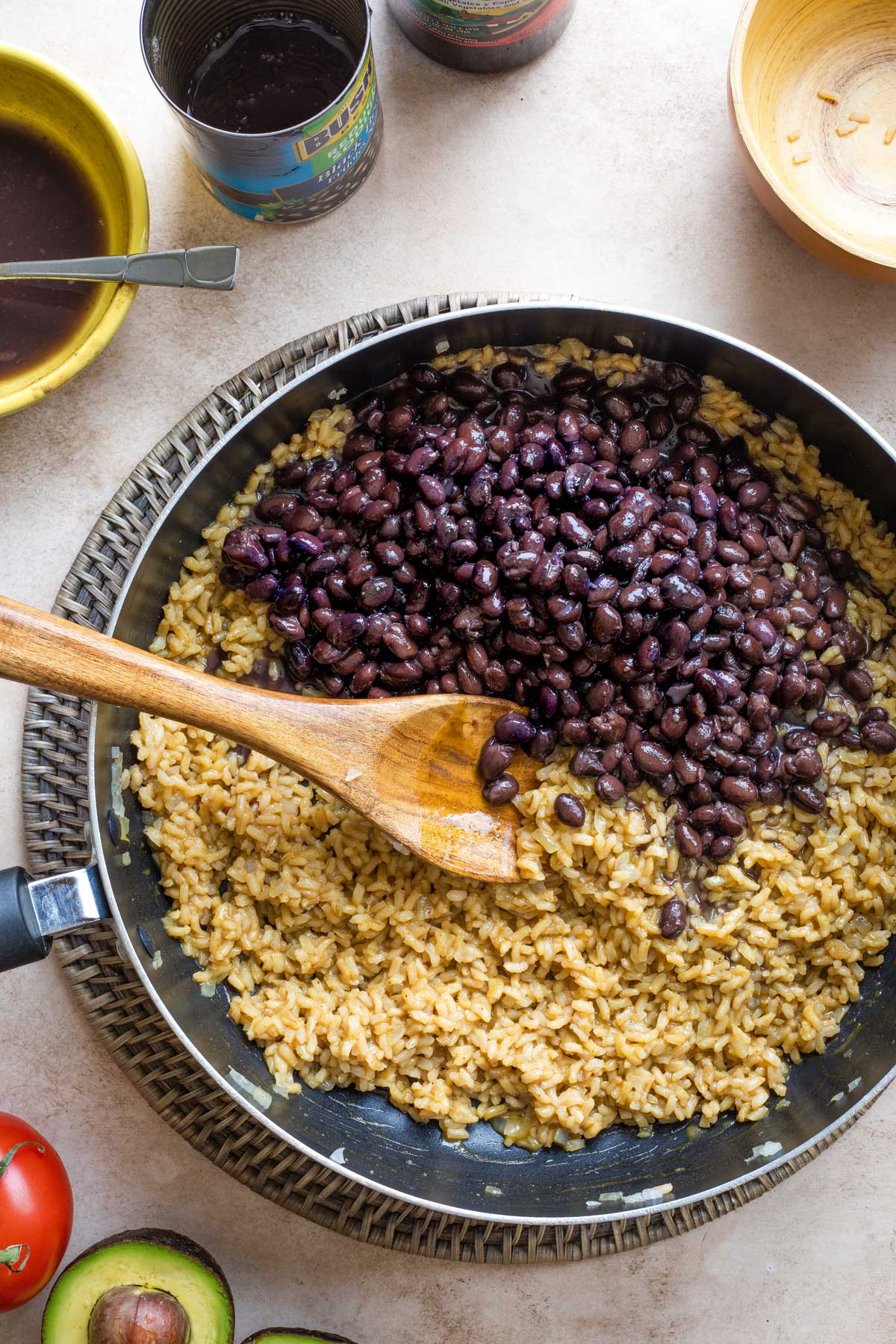
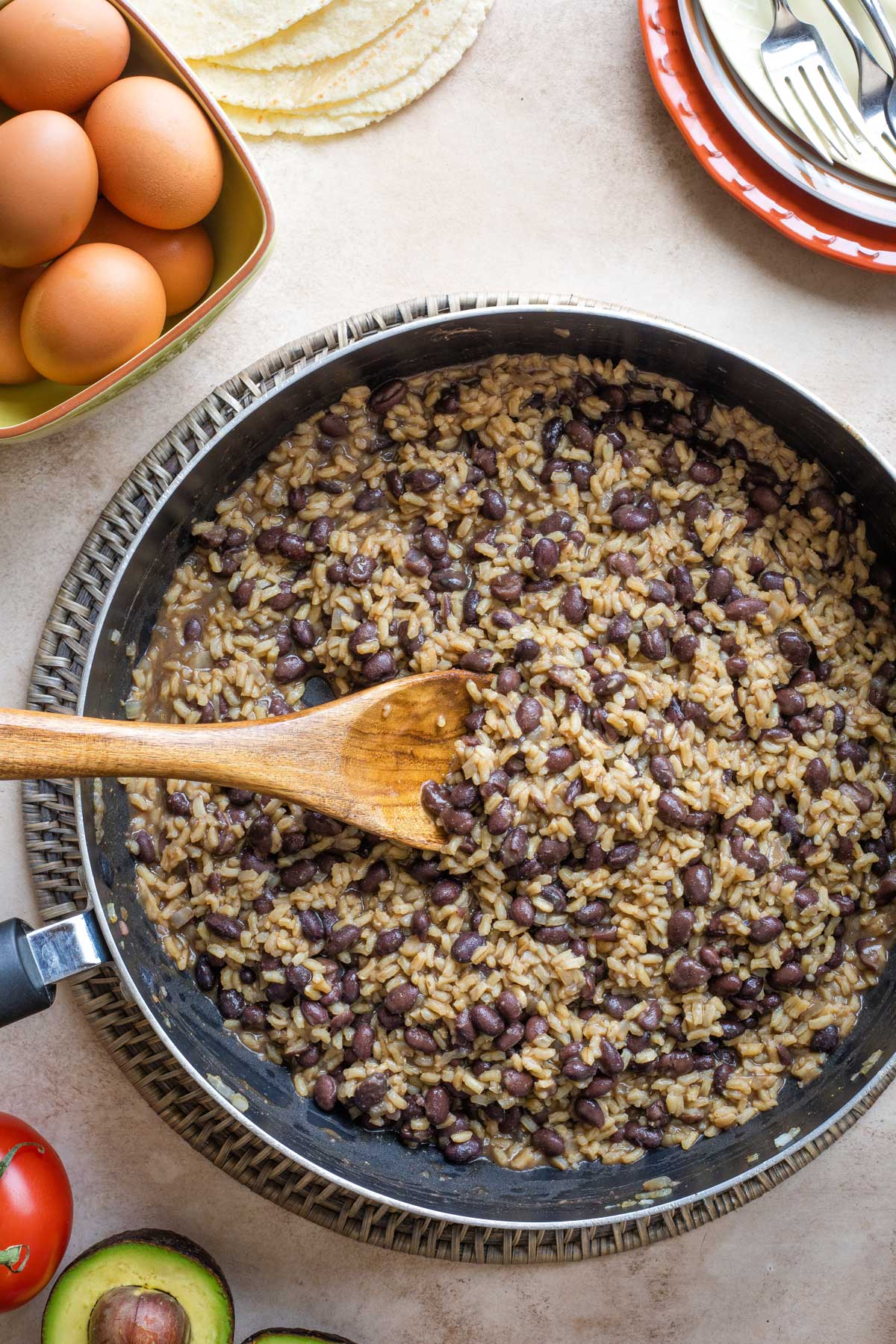
Keep cooking your Gallo Pinto long enough to warm everything through.
Step #5
And BOOM … you’re done!
Serve it up!
Seriously – it’s that easy!
But this is also where it gets fun …
How to Serve It (Toppings and Add-Ons)
Nana taught us her favorite way to fancy it up, though – serve it with:
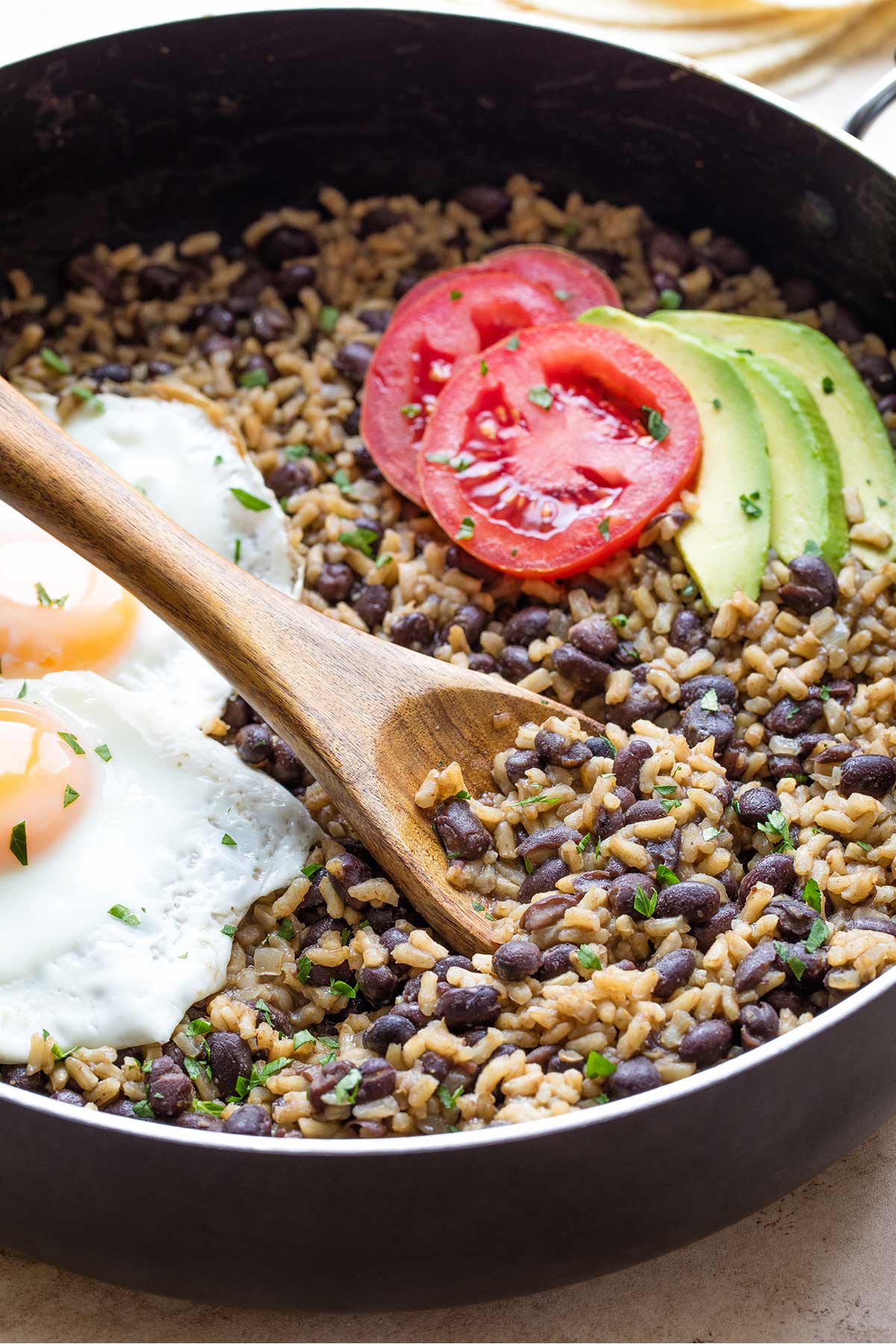
How to Customize It
As I described earlier, authentic Gallo Pinto can take different forms, and each household has their own signature preparation. So you can feel free to switch it up and customize it how you like.
For example …
• The Rice
Most commonly, you’ll find Gallo Pinto made with readily available white rice (which is what Nana used).
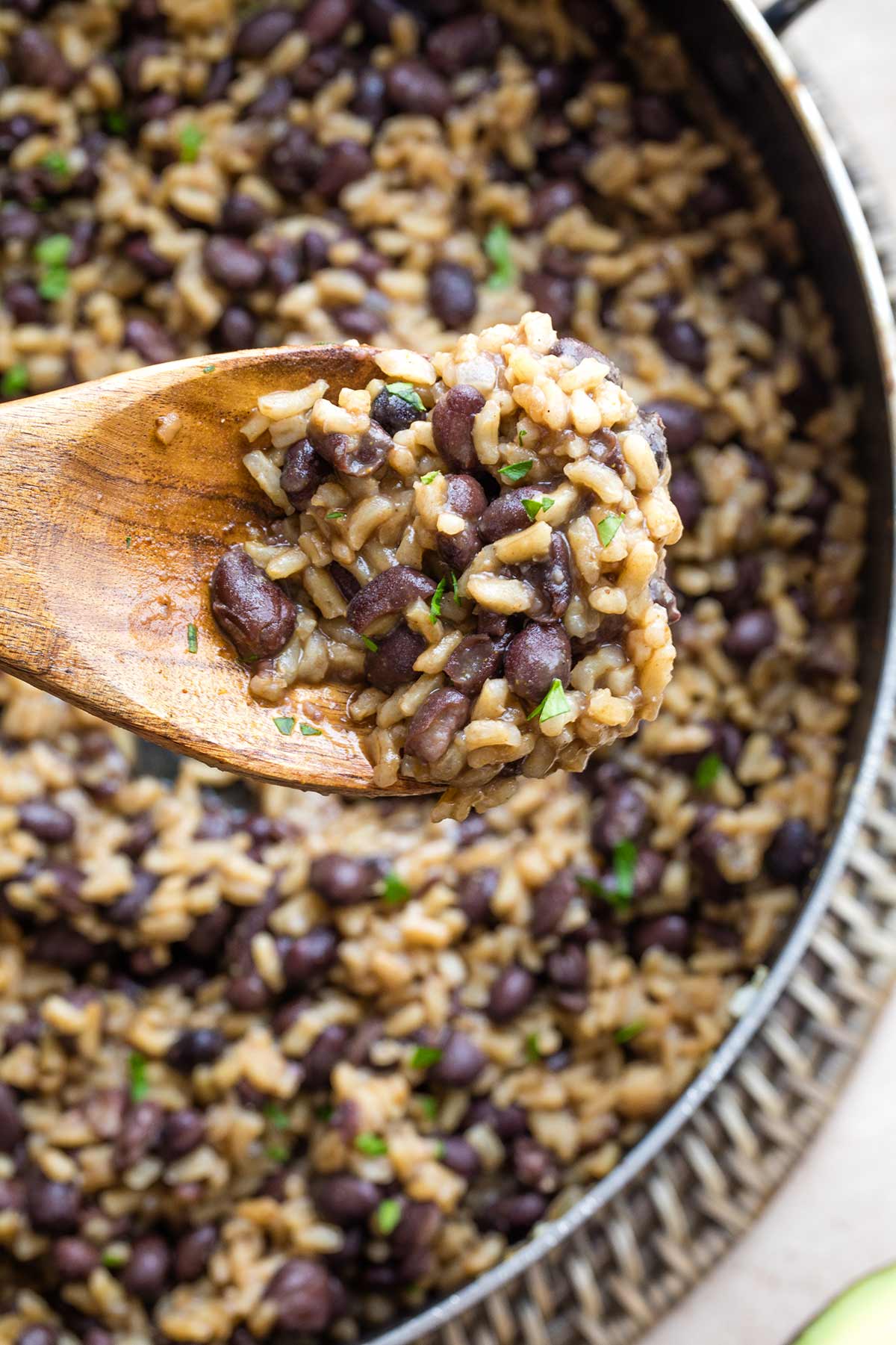
But we like to swap in brown rice for the nutrition boost.
Especially since you totally won’t notice a difference in flavor, why not pump up the nutrition a bit where you can, right?
• The Beans
Typically black beans are the go-to, but you’ll sometimes see versions made with red beans.
Remember, though … DON’T RINSE and DRAIN your Beans!
• The Veggies
While Nana was fiercely determined that no extra veggies enter her Gallo Pinto, we honestly do like it with some chopped onion.
You can still feel authentic if you wanna add those onions (even though Nana would hate it!). Or some chopped bell peppers or garlic.
• The Lizano
Now, as I mentioned before, I really and truly want you to wait to make Gallo Pinto until you get your hands on some Lizano. (Hey, Amazon … help us out here!) Trust me … it’s worth the wait.
But from there, how much you add is up to you. Judging by some of the recipes I’ve seen online since Nana introduced us to this gem of a meal … I’d say Nana’s family pours Lizano with a fairly heavy hand. Which we love! But, as I mentioned earlier, you can adjust it however you prefer.
It’s worth noting, though, that Lizano is a rather high-sodium condiment. So you might prefer to go a little lighter on the Lizano during the cooking process, and pass the bottle at the table so that people can adjust their own portions to taste.
When to Serve Gallo Pinto
Definitely, Gallo Pinto is a very common breakfast food in Costa Rica (and Nicaragua). But it’s also so much more!
• Breakfast
As a breakfast dish, it’s often served with eggs, any way you wanna cook ’em.
Over easy eggs with a runny yolk are fantastic, since the yolk is like an extra sauce that melds into the rest of the dish.
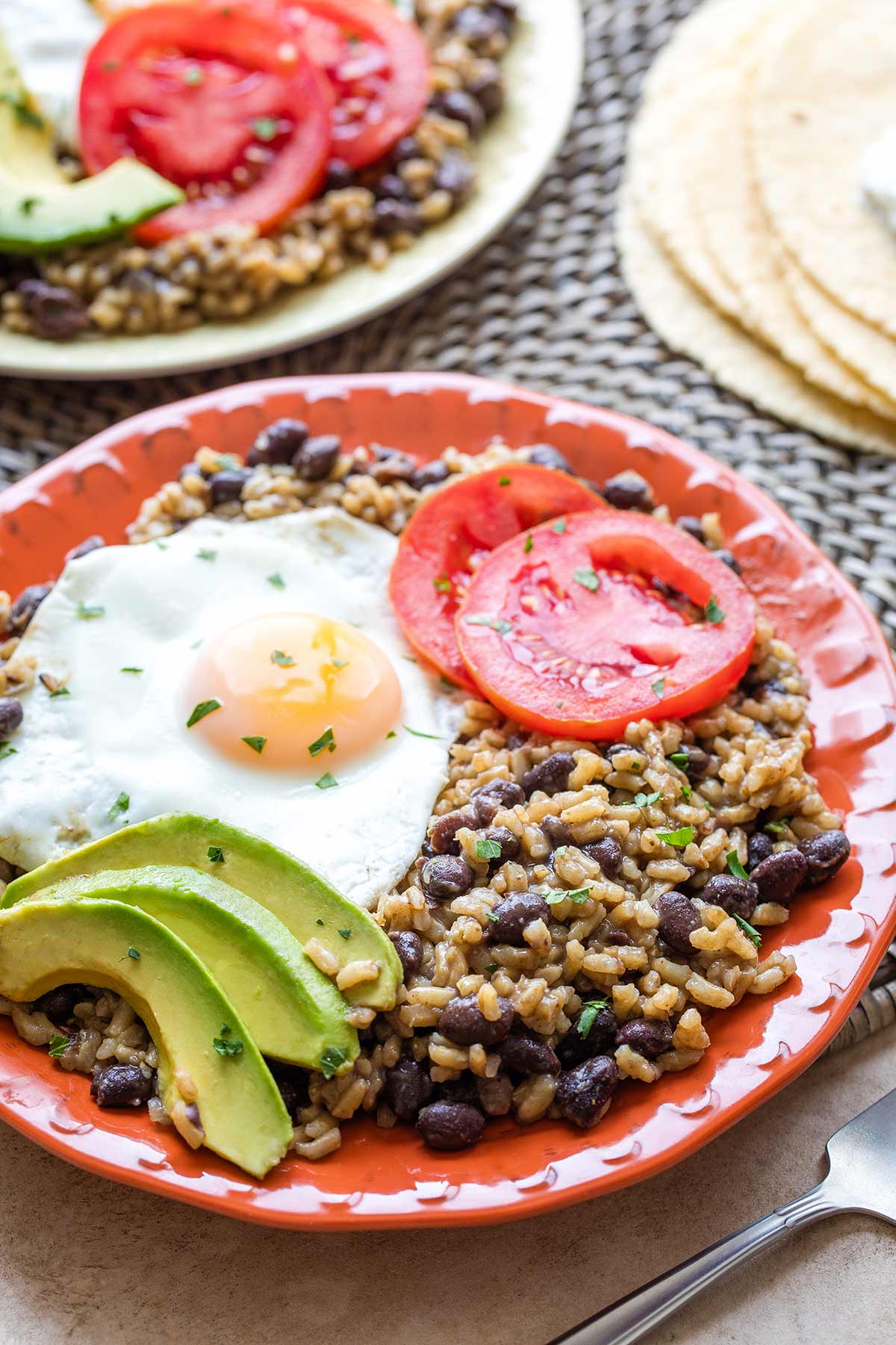
But, honestly, my family loves Gallo Pinto just as much with scrambled eggs, too.
Some fresh fruit is lovely alongside. Maybe some sweet, juicy berries. Or even our refreshing Grape Salad, if you happen to have some in the fridge (which I hope you do!).
• Side Dish
Gallo Pinto makes a terrific side dish for practically any kind of meat. It’s a big upgrade anywhere you’d enjoy “plain” rice and beans. Try it with our
And of course, it’s a slam dunk with all sorts of Central American or Latin American main courses.
• (Vegetarian) Lunch or Dinner Main Dish
Like I’ve said, Nana saw Gallo Pinto as a main course “anytime” food – all day long, every day.
And she’s right – it’s just as great at lunch or dinner as it is at breakfast.
It’s a filling, hearty vegetarian main course. And, especially with an egg on top, you won’t even miss the meat at all.
You basically can’t go wrong with how or when you serve this!
It’s so versatile! And, since you can make it ahead of time, you can easily keep a large batch on hand, ready to go all week long, whenever you’re hungry. That’s what I do. My family is always thrilled when this is waiting for us in the fridge.
Make Ahead Tips – How to Reheat Your Rice and Beans
Keep your Gallo Pinto in a container in the refrigerator, and gently rewarm some of it in the microwave whenever you want.
I recommend adding most of the accompaniments and toppings (tomatoes, avocado, cilantro) fresh, each time you re-warm your Gallo Pinto, since you don’t really want them being reheated in the microwave.
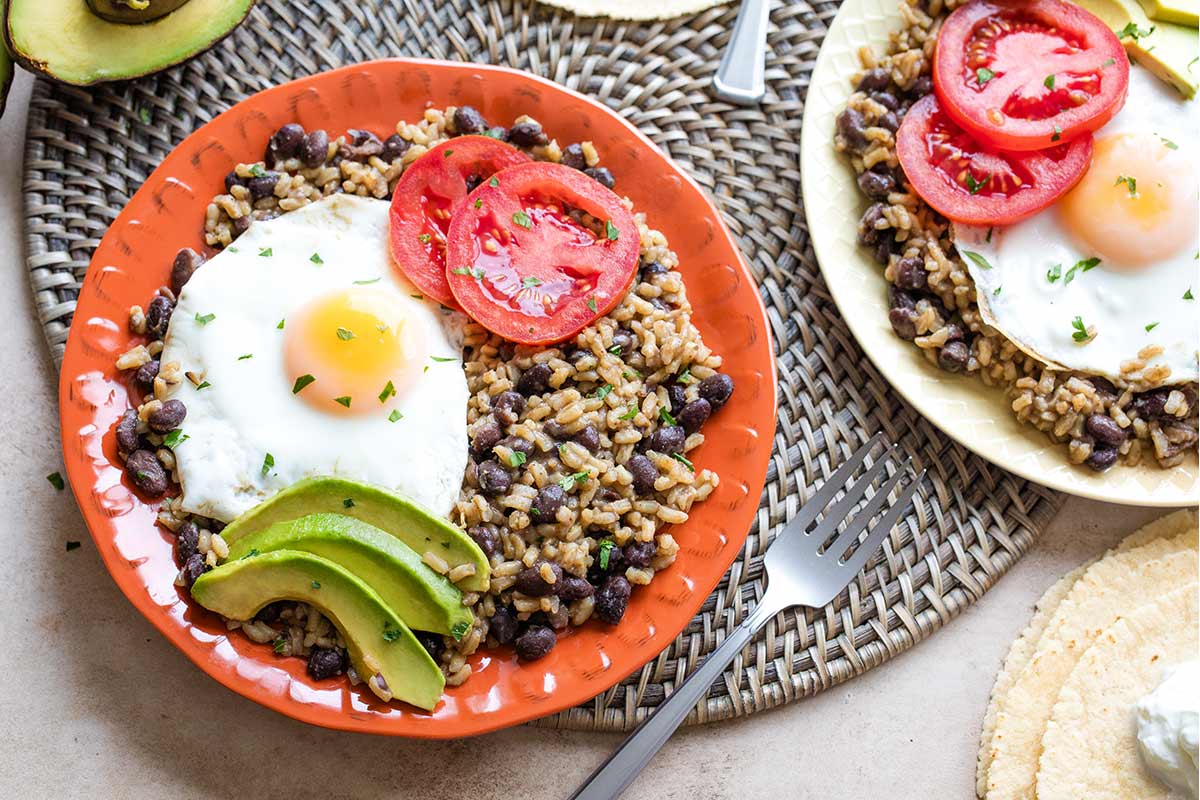
FAQs At-a-Glance
Sure, as long as your pan is big enough.
Most commonly, you’ll see this made with black beans (and that’s how Nana taught us to make it). But, in a pinch, you could sub in some other type – like small red beans – if you prefer. I personally don’t care for larger kidney beans in my Gallo Pinto, but that’s totally a personal call.
I’ve heard that, too. Both sauces are brown and savory and flavorful. But, I absolutely don’t recommend making that swap in your Gallo Pinto. As I mentioned above, Salsa Lizano is a key ingredient in traditional Costa Rican Beans and Rice, and its unique flavor profile isn’t nearly similar enough to Worcestershire for that substitution to work in this recipe. Please trust me that it’s 100% worth it to wait until you have Lizano, which you can easily order on Amazon if you can’t find it at the store.
There were so many wonderful things about hosting Nana as an exchange student. We all treasured the adventures we had with her and the new dimensions she added to our family … oh-so-many memories!
Now that she’s thousands of miles away again, though, this recipe is one way of keeping her close to us.
But, let’s be honest. Remembering our time with Nana isn’t the reason we make this so often. I mean, we could scroll through some pictures if we only wanted to bask in the memories!
Nope … we make Nana’s Gallo Pinto on constant repeat now because we actually just seriously LOVE it that much. Crave it. Miss it when we don’t have some hanging out in the fridge, beckoning deliciously.
I’m not making this up, guys … Gallo Pinto is THAT good.
Why is it so good? I don’t really know. I mean, it’s so simple, you might wonder how it could be this special. But it is.
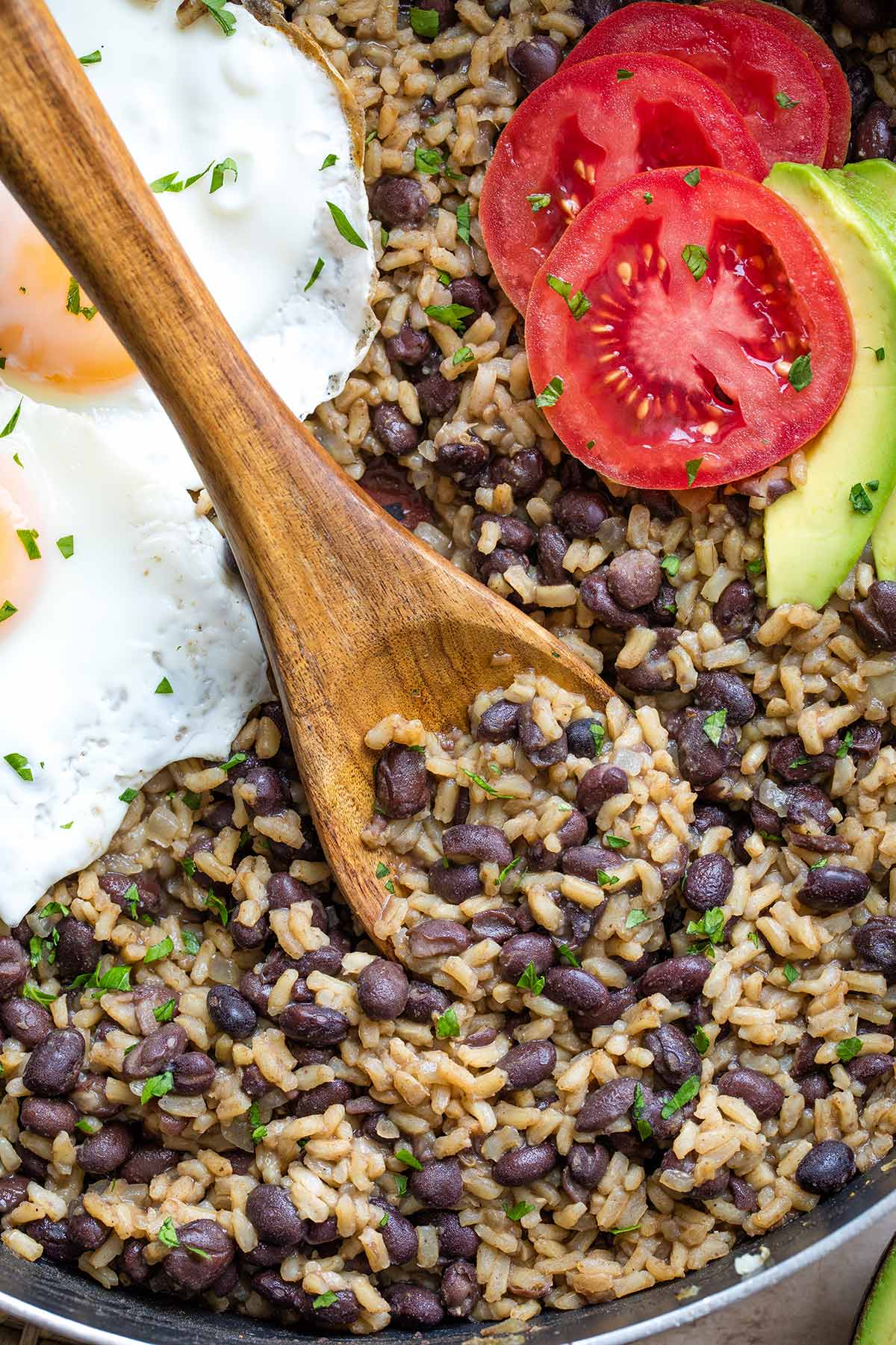
And maybe that’s the best part of all. Something so simple and easy to make, that’s also so darn {addictively, you-will-miss-it-once-it’s gone} GOOD. How perfect – that’s just the way I like my recipes!
Thank you, Nana. xoxoxo

~ by Shelley
Love the Recipe? • Were My Tips Helpful?
__________
Please leave a 5-star-rating by clicking on the stars in the recipe card below. I truly appreciate all your wonderful feedback!
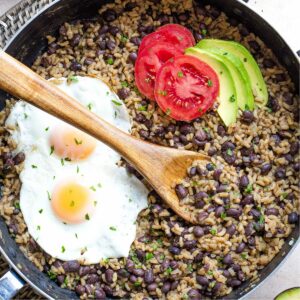
Gallo Pinto
Ingredients
- 2 teaspoons butter
- ½ cup minced onion (optional)
- 4 cups cooked rice (we use brown rice)
- 2 (15-ounce) cans reduced-sodium black beans (do NOT rinse/drain)
- ½ – ⅔ cup Lizano sauce (Salsa Lizano) (see note)
- optional for serving: cooked eggs (any style), sliced tomato or avocado, fresh cilantro, reduced-fat sour cream, and hot sauce
Instructions
- Melt 2 teaspoons butter in a large nonstick skillet over medium heat.
- Add onion (if using) and cook until it's starting to soften but not to brown (about 2 minutes), stirring occasionally.
- Add the rice and cook to warm through (about 1-2 minutes).
- Add Lizano and stir through. Add black beans, scooped straight from the can without rinsing, plus about 2 tablespoons of reserved bean liquid from the cans, cooking until warmed through.
- Serve as desired: as a side dish, or as a main course with (optionally) eggs cooked any way you like and toppings such as tomato, avocado, minced cilantro, reduced-fat sour cream, and hot sauce.
Notes
Nutrition
* Nutrition information should be considered an estimate only, and may vary depending on your choice of ingredients or preparation. No guarantees are made regarding allergies or dietary needs. Always consult a physician or dietician for specific advice and questions.

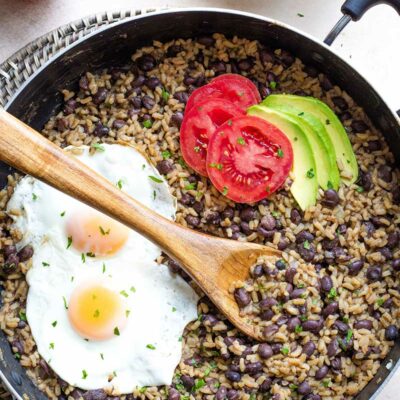
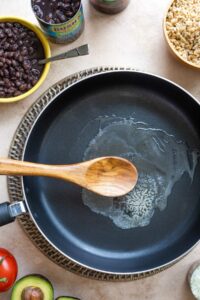
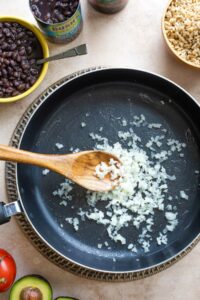
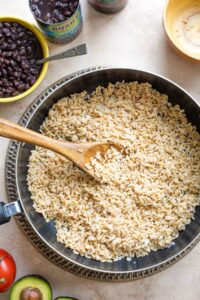
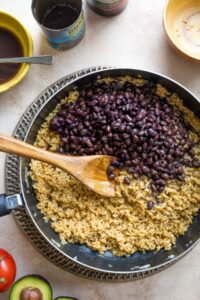
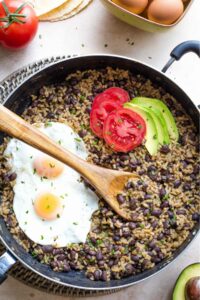

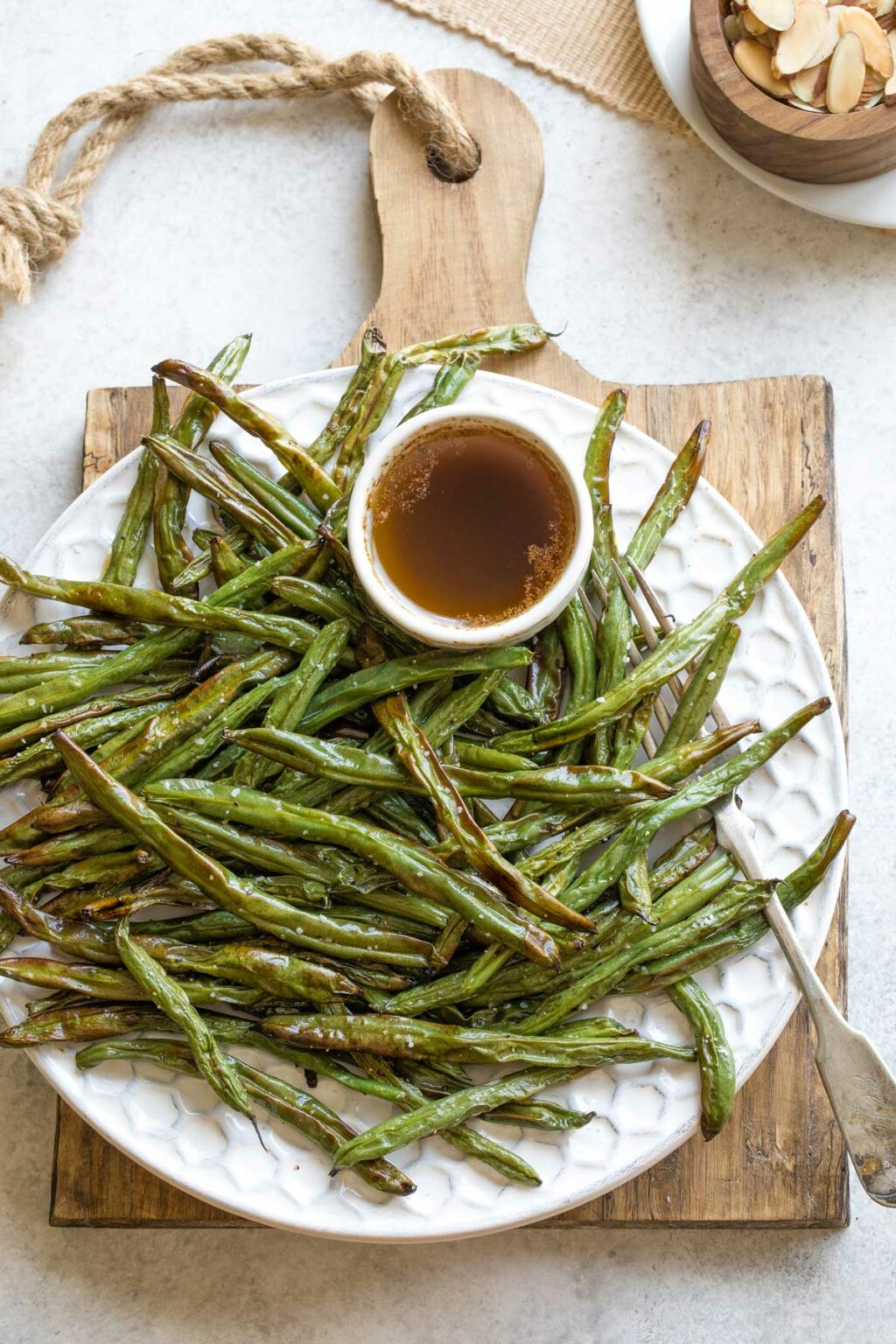

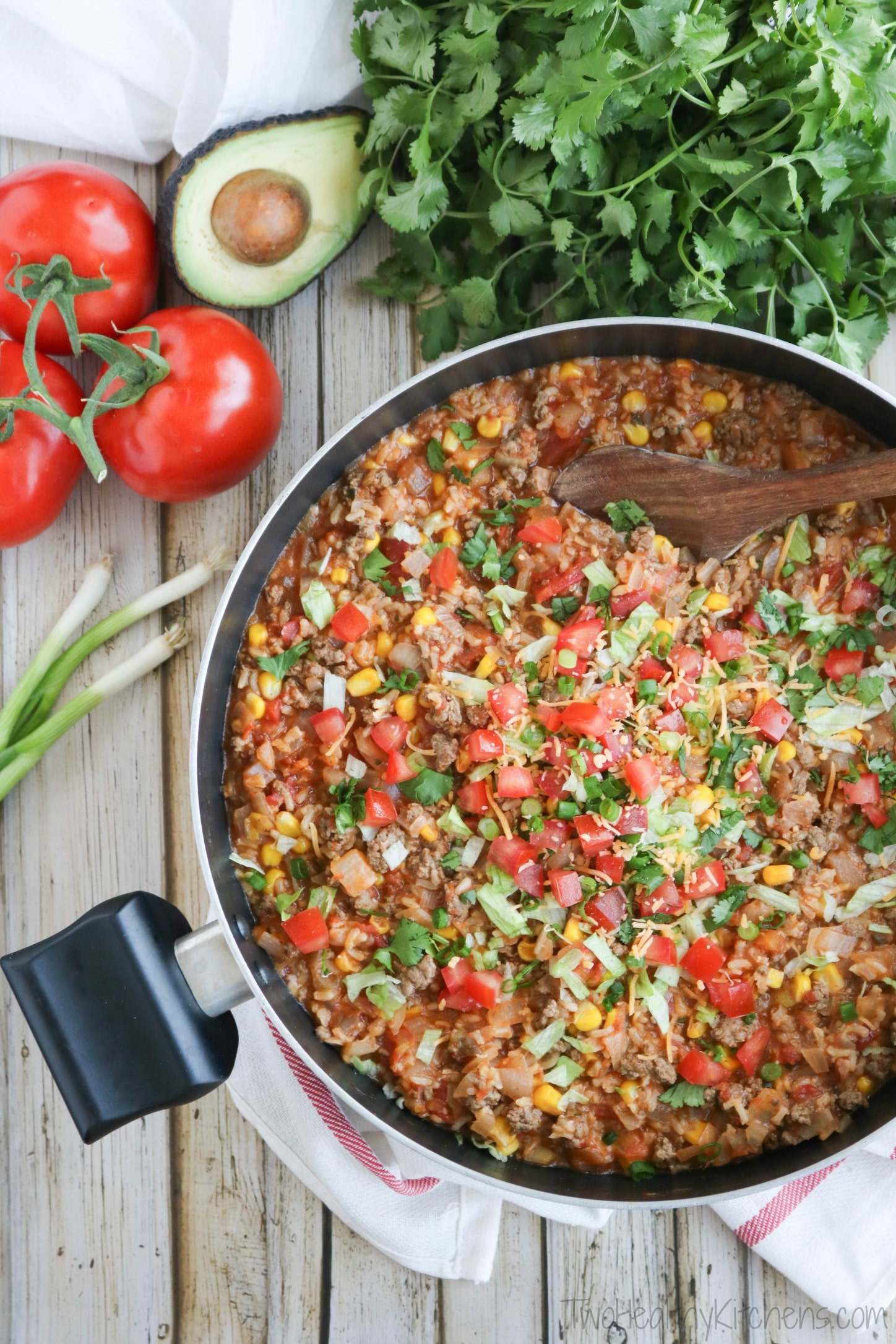
great!
So happy you enjoyed this, Phillis – thanks for the lovely feedback! ~Shelley
Fabulous! I’ll have to check this sauce out.
Oh, I hope you do, Mimi! Lizano sauce is a total game-changer (and so is Gallo Pinto). I can’t wait to hear what you think! 😀 ~Shelley